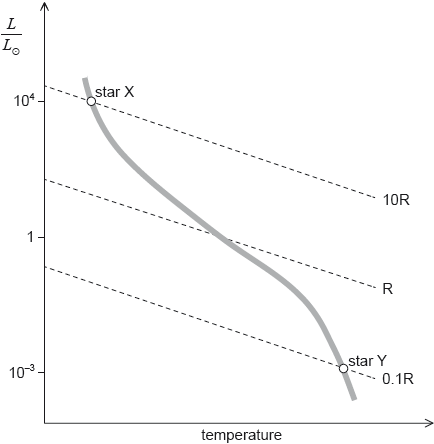| Date | November 2016 | Marks available | 3 | Reference code | 16N.3.SL.TZ0.15 |
| Level | Standard level | Paper | Paper 3 | Time zone | 0 - no time zone |
| Command term | Explain | Question number | 15 | Adapted from | N/A |
Question
Alpha Centauri A and B is a binary star system in the main sequence.
State what is meant by a binary star system.
(i) Calculate .
(ii) The luminosity of the Sun is 3.8 × 1026 W. Calculate the radius of Alpha Centauri A.
Show, without calculation, that the radius of Alpha Centauri B is smaller than the radius of Alpha Centauri A.
Alpha Centauri A is in equilibrium at constant radius. Explain how this equilibrium is maintained.
A standard Hertzsprung–Russell (HR) diagram is shown.
Using the HR diagram, draw the present position of Alpha Centauri A and its expected evolutionary path.
Markscheme
two stars orbiting about a common centre «of mass/gravity»
Do not accept two stars orbiting each other.
i
stars are roughly at the same distance from Earth
OR
d is constant for binaries
Award [2] for a bald correct answer.
ii
= 8.4 × 108 «m»
Award [2] for a bald correct answer.
«A=» B and A have similar temperatures
so areas are in ratio of luminosities
«so B radius is less than A»
radiation pressure/force outwards
gravitational pressure/force inwards
forces/pressures balance
Alpha Centauri A within allowable region
some indication of star moving right and up then left and down ending in white dwarf region as indicated


